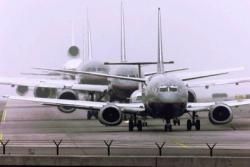Not Even DOT Secretary Peters Is Immune
 Airline delays can be
frustrating for leisure travelers, even heartbreaking if they cause
you to miss a wedding or funeral. But if you're traveling for
business, delayed and cancelled flights cost you money... and the
resulting cost to the nation's economy is coming under scrutiny in
this election year.
Airline delays can be
frustrating for leisure travelers, even heartbreaking if they cause
you to miss a wedding or funeral. But if you're traveling for
business, delayed and cancelled flights cost you money... and the
resulting cost to the nation's economy is coming under scrutiny in
this election year.
In her speech to the Washington Aero Club last Tuesday, US
Transportation Secretary Mary Peters noted even when flights are on
time, the need to plan for delays is, itself, detrimental to
productivity. She shared an anecdote that would be familiar to many
frequent business fliers.
Peters told attendees she took a 7:00 am flight recently from
Washington, DC to New York to attend a 10:00 am meeting with Mayor
Michael Bloomberg. She said she took the early flight, because she
couldn't risk a later one being delayed. In this instance, her
flight arrived on time, which left the nation's top transportation
official to wander around Gracie Mansion for an hour before her
appointment with the mayor.
Of her experience, Peters commented, "It was absolutely not an
efficient use of our time. There were lots of other things I could
and should have been doing."
The US Department of Transportation's Bureau of Transportation
Statistics compiles airline delay data, but admits that official
data most likely underestimate the actual costs to the nation's
economy. In the first 11 months of 2007, for example, 1.6 million
passenger flights were delayed by 15 minutes or more, totalling 170
passenger-years, up from 98 years lost in 2003. The average delay
has grown over that same period from 49 to 56 minutes.
The DOT pegs the monetary costs of those delays at $15 billion,
but many related costs of the delays cannot be calculated. Among
those other factors are time lost by fliers stranded for hours at
airports after delays force them to miss connections. Official
figures also do not account for required early arrivals at
airports, waits in security lines and baggage claim areas, and the
subtle effect of airlines intentionally sandbagging published
flight durations to allow reporting on-time arrivals.
Peters noted in an interview with the Washington Post, "It is
incredible. It means a loss to our economy, a loss to our
productivity; it also means a loss in quality of life."
 So... why do US
travelers put up with the increasing delays and declining quality?
Apparently, for the same reason we keep buying expensive gasoline
-- there's no better alternative.
So... why do US
travelers put up with the increasing delays and declining quality?
Apparently, for the same reason we keep buying expensive gasoline
-- there's no better alternative.
For most business travelers, even delayed airlines are more
efficient than other modes of travel. Even at the airports with the
worst cumulative time wasted for travelers, traffic remains
strong.
DOT statistics show total passenger days lost to airline delays,
just in the first 11 months of 2007, at 3,475 for
Hartsfield-Jackson Atlanta International, 4,619 at Chicago O'Hare,
and 4,897 days total at the three Washington, DC-area airports.
Recent changes to improve the flow through New York-area
airports could be significant. Using the Washington, DC area as an
example, the 10 worst flights in terms of delays from that market
all link through New York metro airports, according to DOT
data.
 Classic Aero-TV: The Switchblade Flying Car FLIES!
Classic Aero-TV: The Switchblade Flying Car FLIES! ANN FAQ: Q&A 101
ANN FAQ: Q&A 101 ANN's Daily Aero-Term (04.12.24): Discrete Code
ANN's Daily Aero-Term (04.12.24): Discrete Code ANN's Daily Aero-Term (04.13.24): Beyond Visual Line Of Sight (BVLOS)
ANN's Daily Aero-Term (04.13.24): Beyond Visual Line Of Sight (BVLOS) ANN's Daily Aero-Linx (04.13.24)
ANN's Daily Aero-Linx (04.13.24)




